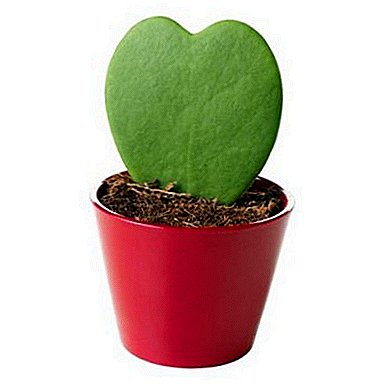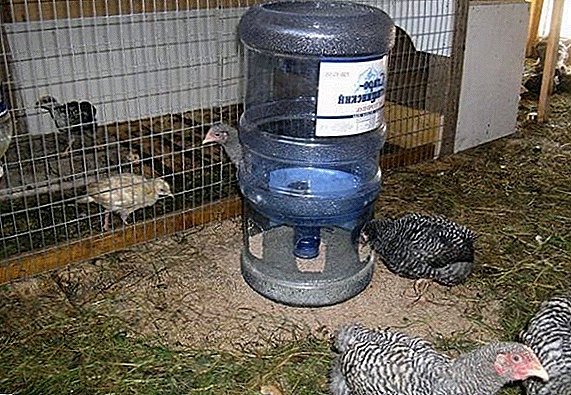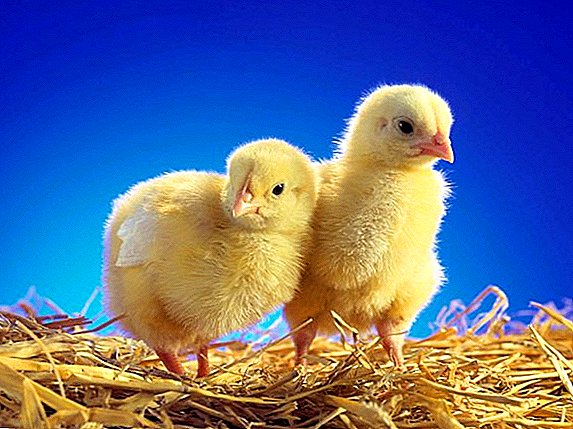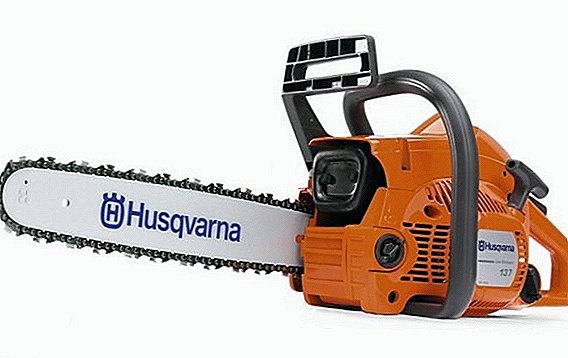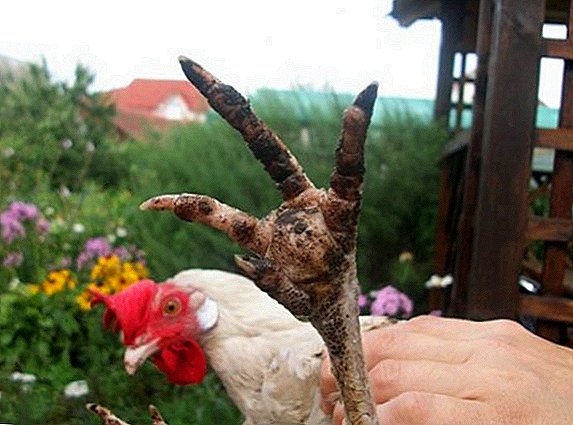 Owners keep chickens in almost every private house - this is not too burdensome and at the same time the family diet is enriched with fresh homemade eggs and poultry meat. Large farms also successfully master this profitable business. But, as in any other occupation, the poultry industry has its own pitfalls, in this case, diseases of the feet in chickens. Let's look at why chickens lose mobility, “fall to their feet”, how to prevent diseases, and what treatment to apply to an already diseased bird.
Owners keep chickens in almost every private house - this is not too burdensome and at the same time the family diet is enriched with fresh homemade eggs and poultry meat. Large farms also successfully master this profitable business. But, as in any other occupation, the poultry industry has its own pitfalls, in this case, diseases of the feet in chickens. Let's look at why chickens lose mobility, “fall to their feet”, how to prevent diseases, and what treatment to apply to an already diseased bird.
Vitamin deficiency
Diseases in which chickens are very limping or practically unable to move are associated with bone damage. One of the possible reasons in this case is the lack of vitamin D in the bird's body.
Possible causes of beriberi:
- defective food, in which there is not enough calcium and phosphorus;
- poor lighting in the hen house;
- lack of sun (ultraviolet radiation);
- content in cramped without walking.
Symptoms:
- chickens are inactive and lose their appetite;
- feathers fall from the tail and fly feathers from the wings;
- feathers in disarray (disheveled);
- chickens are curved tibial bones, they limp in motion;
- with palpation, curvature of the spine and paws, thickening on the ribs are felt;
- in young birds, the horn plate of the beak and the rib cage softens. If not treated, then a complete softening of the bones develops.

Treatment:
- Include the minerals and vitamins (tricalcium phosphate) in the bird menu.
- Daily feed green feed.
- Extend the lighting time of the coop (from 6 am to 8 pm).
- Provide pets walking in the fresh air.
Important! As soon as the owner notices that a sick chicken appeared in the chicken family (lame, unwilling to get up, trying to sit down constantly) - it must be urgently isolated from relatives, examined, diagnosed, and started treatment. It is necessary to isolate the diseased individual quickly, since healthy birds will peck at their sick product. and do not let her to the trough. For the rest of the birds release already recovered chicken.

Prevention: As a preventive measure of avitaminosis in birds, it is recommended to pay attention to the feed - food should be complete. Multivitamins are added regularly to mixed feeds.
It will be interesting for you to read about what, how and how much to feed domestic chickens, what is feed, how to prepare feed for chickens and for adult birds.
Arthritis and tendovaginitis
Arthritis is a disease in which the bags of the joints become inflamed and the tissues near the joint. Most often, young broilers are prone to arthritis. Tendovaginitis is a disease characterized by inflammation of the tendons. Usually it is sick adults and old chickens.
Causes:
- mechanical damage - the chicken fell or hit;
- viral or bacterial infection, which contributed to the development of the disease;
- poor, unbalanced feeds;
- confusion and overcrowding in the hen house;
- wet and dirty floor, no dry bedding.
 Chickens with such diseases suffer a lot, they experience constant pain when moving, they cannot climb and stay on their roost.
Chickens with such diseases suffer a lot, they experience constant pain when moving, they cannot climb and stay on their roost.Symptoms:
- chickens walk badly, limp, often sit down;
- knee or finger joints are enlarged and have a fever (felt when touching);
- all day the bird sits in one place.
It will be useful for you to read about the diseases of chickens and methods of their treatment.
Treatment:
- Conduct a course of treatment with antibiotics or antiviral drugs.
- The course of treatment is five days.
- The medicine is drunk individually to each sick bird or mixed into the feed, if there are many patients. The most effective method of treatment is intramuscular injections of the drug (once a day at the dose indicated in the annotation to the preparation).

Did you know? Chickens are very sociable and come together in a flock in which there is a hierarchy. Those who are at a higher level in the hen’s hierarchy are the first to gain access to food and nesting sites. Adding a new or removing an old chicken or rooster from a chicken family can cause great stress to all birds, leading to battles and injuries until a new hierarchical order is established.
Prevention:
- It is necessary to keep the room clean (do daily cleaning).
- As required (when contaminated or wetted) litter on the floor is changed to dry.
- Arrangement of closed feeders, eating food from which the chicken can not get to the food with their feet and rake it. In addition to saving feed, it will help the legs of the chicken remain unpolluted.
- It is necessary to take care of the good immunity of pets - in the bird menu should be included green and juicy food (grass, nettle, grated fodder beet), vitamins, macro-and micronutrients.

For the prevention of many diseases in the diet of poultry should be added wheat germ and meat and bone meal.
Chicken limp
Causes of lameness:
- injury to the skin of the fingers or feet (glass, sharp surfaces);
- dislocations of the joints and sprains;
- leg bruises and nerve clamping;
- muscle injury;
- lack of minerals and vitamins;
- kidney disease (nerves that control the activity of feet in birds, pass through the kidneys);
- too much body weight and, accordingly, a large load on the legs.

Symptoms:
- the chicken is lame, with time the lameness increases;
- the sore joint swells and increases in size, the leg is turned out at an unnatural angle;
- the bird rests unsteadily, the tremor is visually clearly visible;
- breaking into a run, the hen falls through a small distance;
- the patient gets up with difficulty, mainly sits (even when receiving feed).
Treatment:
- The sick pet is trapped and deposited separately from the rest of the chickens.
- Examine for cuts or punctures pads, fingers and leg joints.
- If an injury is found, it is enough to treat the pet and keep it in isolation until the amendment, and also to feed it well.
- Found punctures, abrasions and other skin disorders are treated with an antiseptic (hydrogen peroxide, iodine or brilliant green).
- In the case when no wounds are found, the owner of the bird should contact a veterinarian for help.

Prevention:
- You can not lift the birds by the legs - this is often followed by injuries and broken bones.
- Before the roost you need to provide an empty space on which the chickens land, fly off or jump off the roost.
- In the chicken house and on the territory where the chickens walk, should be clean, dry and safe. Wallowing broken glass or sharp objects are not allowed so that the birds do not get hurt.
Knemidokoptoz
Knemidokoptoz - disease, popularly known as "calcareous feet." This disease is quite common. With timely diagnosis, it is easy to cure. This is a contagious disease: if no action is taken, the whole chicken family will soon become infected. Knemidokoptoz poultry without treatment develops into a chronic disease.  Infection occurs when it gets under the skin of the pathogen - a scabies mite. Infection of healthy chickens from the patient occurs through direct contact (they sit on a perch next to each other, pecking food next to them), through litter on the floor, through feeders and troughs.
Infection occurs when it gets under the skin of the pathogen - a scabies mite. Infection of healthy chickens from the patient occurs through direct contact (they sit on a perch next to each other, pecking food next to them), through litter on the floor, through feeders and troughs.
We advise you to read about how to make a drinking bowl and a feeder for chickens with your own hands.
Symptoms:
- Ticks penetrate the scales covering the legs of the bird.
- The entire life cycle of mites passes under this scaly cover: the passages where microscopic insects make an egg-laying are biting, and the larvae also develop there.
- The presence of ticks and their livelihoods in chickens cause severe scabies and itching.
- One of the symptoms of tick infestation is that chickens do not want to go to the chicken coop, they are worried.
- Tick activity increases at night and in warm weather (or in a well-heated room).
- Over time, the scales on the legs of the birds exfoliate, become covered with a whitish layer (resembling a lime scale) and a little later fall off.
- If the mites have settled between the toes of the chickens, then soon there will be bumpy growths.

Treatment:
- Prepare a strong soap solution (diluted with 50 grams of soap in 1 liter of warm water).
- Pour the solution into a narrow, but deep tank. The container is chosen so that the liquid poured into it completely covers the legs of the chicken before the feather cover begins.
- The sick bird is caught and lowered into the soap solution for 1 minute.
- After that, they immediately grease the legs with a 1% solution of creolin or birch tar.
This treatment is sure to help, as scabies is easily treatable.
Did you know? The usual layers are omnivorous birds, which means that they can eat both vegetable and meat food. In the wild, chickens eat grass seeds, insects, and even small animals such as lizards and wild mice. Homemade chickens usually eat ground and whole grains, herbs and other plant foods.
Video: treatment of chlamydocoptosis in chickens Prevention:
- Once in 10-14 days, the owner must inspect chickens for manifestations of knemidocoptosis.
- Timely detection and isolation of tick-infected birds will not allow all pets to become infected.
Important! Not a single case of a man being infected with ticks was recorded. Ticks from chickens are not transmitted to humans.
Crooked fingers
Chickens can get this disease in the first month of life. With crooked fingers, the chicken walks, waddling, leaning on the outside of the foot. Chickens with such a defect are not left to the tribe, since there is always the possibility that this is a genetic deformity.  Causes of the disease:
Causes of the disease:
- the concrete floor of the chicken coop without dry and warm bedding;
- mechanical foot injury;
- keeping young stock in boxes with a mesh floor;
- non-compliance with the incubation conditions;
- bad heredity.
Symptoms: peculiar gait, chicken with crooked fingers rests when walking on the side surfaces of the legs.
Treatment: uhthen the disease is not treated.
Prevention:
- From the first days of life, bird birds should be provided with a comfortable environment (warm and even floor, dry litter).
- No eggs should be taken for incubation from chickens with a crooked finger disease.
- When incubating eggs, one should strictly adhere to the incubation regime.

Did you know? Chickens love to bathe in the dust. Dust baths, in addition to the pleasure they bring, help birds to fight insects in the feather cover.
Curly fingers
Curly fingers are a disease in which they paralyze the fingers, the hen walks on tiptoes, while her fingers are in a bent (down) position. Curled fingers do not straighten even under strong pressure.
Poultry owners often look for answers to such questions: what are the causes of diarrhea in chickens, why chickens are balding, and how to get worms from chickens.
As in the case of crooked fingers, the chicken’s fingers get a disease in the first two or three weeks of life. Sick young animals die most often, rare surviving chickens have a clear delay in development and growth.
The cause: Riboflavin deficiency (vitamin B2) in feed.
Symptoms: sick chicken walks only on tiptoe, leaning on fingers twisted downwards. 
Treatment:
- If the disease is diagnosed on time and the disease is not running, then the young animals are fed or drunk multivitamins with a high content of vitamin B2.
- In adult chickens, curly finger disease is not treated.
Prevention:
- Food should be balanced, it should contain all the minerals and vitamins necessary for the young birds.
- If the disease is congenital and not acquired shortly after birth, then there is a genetic failure in chickens whose eggs were incubated. Such manufacturers need to be changed.
Important! If the disease is diagnosed early, the poultry farmer can independently heal his chickens. If it is not possible to determine the disease on your own, you need to seek help from a veterinarian to prevent infection of the entire chicken population.

Gout
The second name for gout is urolithiasis. This disease is manifested in the deposition of salts of uric acid in the muscles and joints of the legs.
We recommend reading about how a rooster fertilizes a hen, whether a rooster is needed for the hens to carry eggs, when the hens of the pullets begin to rush, what to do if the hens do not rush, why do the hens carry small eggs and peck at them.
Symptoms:
- appetite disappears, the chicken loses weight, and also becomes sedentary and lethargic;
- cones appear in the area of the joints, the joints further deform and do not bend;
- this disease affects not only the legs, but also the internal organs (kidneys, liver, intestines).
Treatment:
- Feed the birds with solutions of baking soda (2%) or Carlsbad salt (0.5%).
- To remove the salt from the body of birds, they need to give "Atofan" (for one bird 0.5 grams of the drug per day).

Prevention:
- Mix vitamin A in feeds.
- Reduce the amount of protein foods.
- Make mandatory daily walking of chickens in the fresh air.
- Increase the area of the enclosure for walking.
Did you know? Scientists suggest that chickens evolved from long-extinct dinosaurs and are their closest living relatives.
Tendon displacement
Diseases of chickens with a large body mass often begin precisely with perosis (tendon displacement), so it is important to diagnose it in time and begin treatment. This disease is triggered by rapidly growing weight and a deficiency in the growing body of vitamin B. All this is characteristic of young birds. Sick chickens do not drink or eat, and eventually die. 
Learn how to keep chickens in the winter and whether they can be kept in cages.
Symptoms: chickens swell and hock joints unnaturally twist.
Treatment: include in the bird ration additional portions of vitamin B and manganese. This will alleviate the symptoms a bit, but it will not solve the problem completely.
Prevention:
- For breeding chicken stock, purchase genetically pure material (producers must be healthy).
- Pay attention to a balanced diet and vitamins for young birds.
Did you know? Electrophobia is the name for an irresistible fear of chickens.

The list of leg diseases in chickens can be continued with infectious diseases:
- pasteurellosis;
- paratyphoid;
- ornithosis;
- Marek's disease;
- coccidiosis.
We advise you to read about the treatment of chicken diseases such as coccidiosis, colibacteriosis, pasteurellosis and Newcastle disease.
We hope that the above descriptions of foot diseases in chickens will help bird owners to determine in time the type of disease and methods for its treatment. Compliance with the above preventive measures when keeping birds in most cases will help to avoid the development of diseases.




